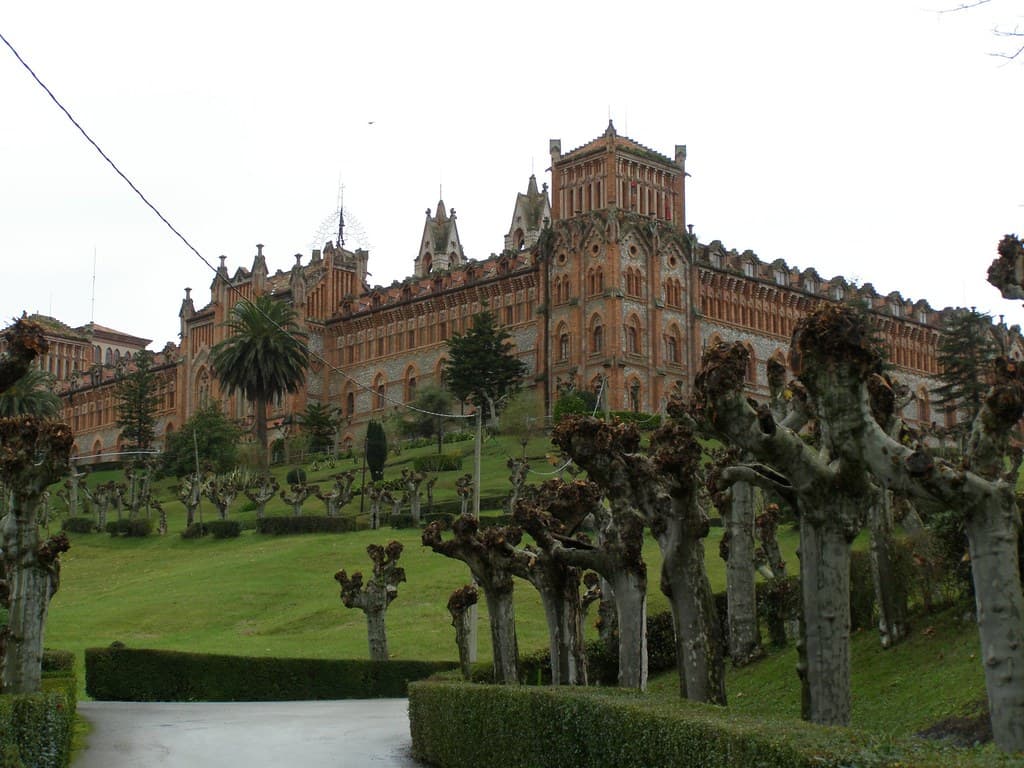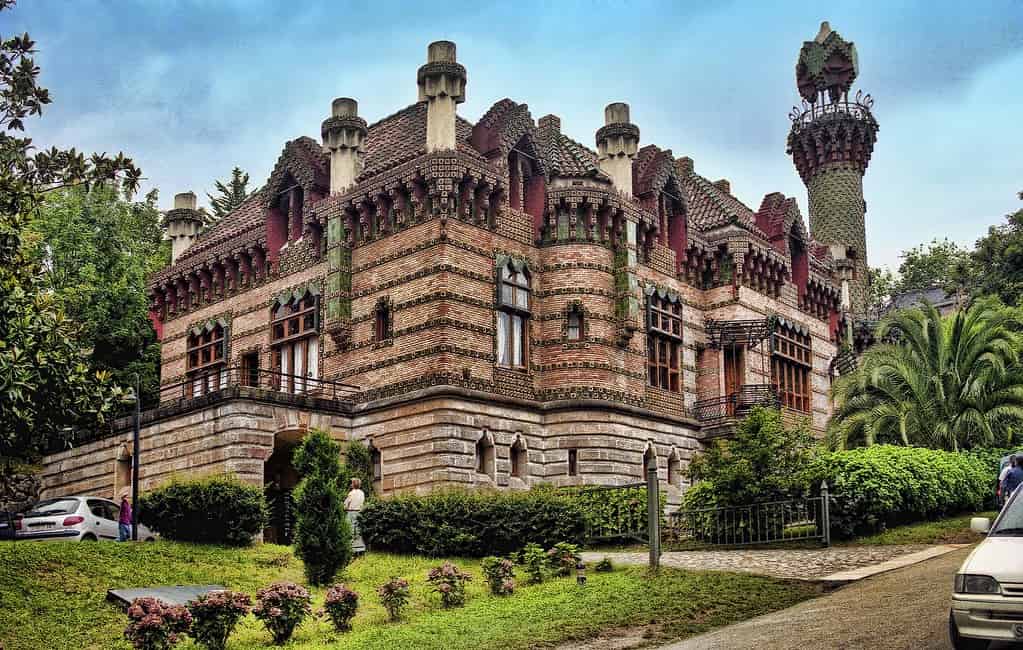
Comillas is not just any village. In its streets, history, architecture, and landscapes blend together, surprising you at every step. Its old town, beaches, and modernist buildings make it an unmissable destination in Cantabria.
But beyond the obvious, this place hides details that deserve to be explored at a leisurely pace. Did you know that it is home to one of the few works by Gaudí outside Catalonia? Or that the cemetery offers one of the most stunning views in the region? Join us in discovering the corners that make Comillas a must-stop on your journey along the Camino del Norte.
Índice de contenidos [Ocultar]
- 1 Why choose the Camino del Norte?
- 2 Gaudí’s Capricho: an exceptional modernist masterpiece
- 3 Pontifical University: history and monumentality
- 4 Comillas Beach: golden sand and unbeatable views
- 5 The Cemetery and its impressive sculpture
- 6 Plaza de la Constitución: traditional atmosphere
- 7 Palacio de Sobrellano: luxury and splendour of the 19th century
- 8 Discover Comillas with time and curiosity
Why choose the Camino del Norte?
Before we begin, from Mundiplus, specialists in Camino de Santiago trips, we want to tell you why you should choose the Camino del Norte. This route stands out as an exceptional option for those looking to combine adventure, history, and coastal landscapes of remarkable beauty.
This route, which runs along the Cantabrian coast, offers an intimate experience with nature. It allows pilgrims to enjoy both expansive beach stretches and lush hills and imposing cliffs. Additionally, its path encourages direct contact with local culture and a unique cuisine, making it ideal for those seeking a journey filled with contrasts and nuances.
While there are other pilgrimage options, each route has its own charm. In fact, the Camino de Santiago from Irún to Bilbao is characterised by its urban atmosphere and proximity to the coast. Later, green valleys and impressive cliffs appear along this same stretch.
The uniqueness of this route lies in the harmony between seafaring tradition and inland life. This journey invites a slow and reflective experience, where each step becomes an opportunity to discover stories and customs that enrich each pilgrim’s personal journey.
By comparison, other routes such as the Camino from Lugo to Santiago or the Camino from Ourense to Santiago also have much to offer in terms of history, tradition, and personal challenges. However, the Camino del Norte stands out for its ability to blend urban life with nature and for the visual impact of its coastal landscapes.
Another notable aspect is the ability to adapt the journey to different paces and preferences. The route offers both physically demanding sections and segments ideal for a leisurely enjoyment of nature and cultural heritage. This allows pilgrims of all ages and fitness levels to find a tailored experience on the Camino del Norte.
Gaudí’s Capricho: an exceptional modernist masterpiece

The Capricho de Gaudí, also known as Villa Quijano, was built between 1883 and 1885 at the request of Máximo Díaz de Quijano, a wealthy man who made his fortune in the Americas and was the brother-in-law of the Marqués de Comillas, Antonio López y López.
This summer house is one of Gaudí’s first works and reflects his boundless imagination, combining elements of Eastern art and Arab architecture.
The building is characterised by its innovative use of brick, glazed ceramics, and forms inspired by nature, making it unmistakable. The design anticipated some of the construction and decorative solutions that Gaudí would later use in projects such as the Sagrada Familia and Park Güell.
The side tower stands out for its verticality in an otherwise horizontal structure. The façades show the alternation of horizontal bands of exposed brick and ceramic friezes with plant motifs.
Today, the Capricho functions as a museum and is one of the most photographed placess. It attracts visitors from all over the world, not just pilgrims, due to its unique architecture and cultural significance.
Pontifical University: history and monumentality
Located at the top of a hill, the Pontifical University is a 19th-century academic and architectural landmark. Its neo-Gothic façade and interiors adorned with Mudéjar and modernist details are impressive. Although it no longer serves university functions, it can be visited with guides who explain its history and architectural importance.
The Pontifical University was founded in 1892 and played a key role in religious and civil education in Spain during the 19th century. The architecture reflects the influence of various styles, such as neo-Gothic and modernism. All of this makes it a unique place to explore.
Comillas Beach: golden sand and unbeatable views
Comillas Beach is an ideal destination to relax and enjoy the Cantabrian Sea. The golden sand and crystal-clear waters make it perfect for strolling, practicing water sports, or simply basking in the sun.
The promenade connects to the historic centre, allowing visitors to explore the area without having to travel too far. The beach is also a popular spot to watch the sunset, with unbeatable views of the sea and the surrounding mountains.
Moreover, its proximity to the historic centre makes it easy to access local cafés and restaurants, where you can sample the typical cuisine of the region. With a length of 900 metres and a well-equipped promenade, the beach is a welcoming place that combines natural beauty with urban comfort.
The Cemetery and its impressive sculpture
At the top of the village, the Comillas Cemetery offers a spectacular panoramic view of the Cantabrian Sea. The most striking feature is the sculpture of the “Exterminating Angel“, a work by sculptor Josep Llimona that crowns one of the ancient ruins of the necropolis. This sculpture imposes itself and gives the place a unique character. It combines history and art in a striking way.
This is a tranquil and reflective site, ideal for walking and contemplating the beauty of the surroundings.
Plaza de la Constitución: traditional atmosphere
The centre of Comillas’ historic district is the main square, the Plaza de la Constitución. Surrounded by traditional buildings with wooden balconies, here you’ll find cafés and restaurants where you can taste the local cuisine. The Church of San Cristóbal, which stands out for its mountainous Gothic style, is also located nearby.
The Plaza de la Constitución is a lively place. Local events and festivities are held here. The traditional and welcoming atmosphere invites visitors to sit at a terrace and enjoy the surroundings, surrounded by the historic architecture of the village.
Palacio de Sobrellano: luxury and splendour of the 19th century

The Palacio de Sobrellano was commissioned by the first Marqués de Comillas, Antonio López, at the end of the 19th century. Designed by Martín Sarriá and decorated with modernist elements, it stands out for its opulence and period furniture. In front of the palace is the chapel-pantheon, a work with neo-Gothic details that also deserves a visit.
The mentioned palace is an example of the luxury and splendour of the time. It reflects the economic power of this family. The architecture and decoration make it a must-visit place.
Discover Comillas with time and curiosity
Comillas is a destination that combines history, architecture, and nature in one place. Walk through its streets, enjoy its gastronomy, and explore the surroundings, you’ll notice there’s always something that surprises you.
One day may be insufficient to appreciate all that this destination has to offer. Also, we remind you that you must continue your journey and reach the Cathedral of Santiago.










 Hello, would you like more information?
Hello, would you like more information?